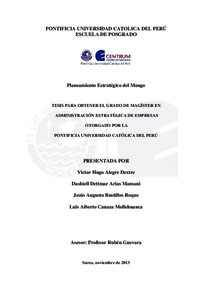| dc.contributor.advisor | Guevara Moncada, Rubén | |
| dc.contributor.author | Alegre Dextre, Victor Hugo | es_ES |
| dc.contributor.author | Arias Mamani, Dashiell Dettmar | es_ES |
| dc.contributor.author | Bustillos Roque, Jesús Augusto | es_ES |
| dc.contributor.author | Canaza Mollehuanca, Luis Alberto | es_ES |
| dc.date.accessioned | 2017-05-31T16:53:59Z | |
| dc.date.available | 2017-05-31T16:53:59Z | |
| dc.date.created | 2013 | |
| dc.date.issued | 2017-05-31 | |
| dc.identifier.uri | http://hdl.handle.net/20.500.12404/8713 | |
| dc.description.abstract | El mango se ha convertido en el fruto tropical más valorado por sus beneficios
nutricionales y características organolépticas. Por ello, se ha creado una oportunidad de
negocio, debido al incremento de la demanda a nivel mundial por el consumo de frutas y
vegetales. Dentro de este contexto, las exportaciones de mango peruano se vienen
incrementando en los últimos años, lo cual beneficia a productores y exportadores peruanos,
así como también a los países competidores. El Perú presenta ventajas comparativas tales
como suelos fértiles, variedad de climas y ubicación geográfica; asimismo, el mango peruano
tiene ventajas competitivas, como la excelente calidad del producto y sus propiedades
organolépticas.
En el análisis externo, se puede mencionar que el Perú presenta estabilidad política y
lidera el crecimiento económico en la región, lo cual favorece a la cadena de valor del Mango
peruano. Sin embargo, a partir del análisis interno, se ha planteado una serie de objetivos: (a)
mejorar la asociatividad entre productores y exportadores, (b) incrementar el acceso al
financiamiento, (c) ampliar la oferta exportable, (d) promover la implementación de
certificaciones internacionales de calidad, (e) implementar programas de capacitación, y (f)
incrementar el consumo interno. Por otro lado, los principales mercados del Mango peruano
son EE.UU y Europa, cuyos principales abastecedores son México y Brasil respectivamente.
En ese sentido, se requiere penetrar en los mercados, diversificar productos y desarrollar
mercados en Asia, aprovechando la preferencia del Mango por los consumidores.
En la presente tesis, se desarrolla el planeamiento estratégico del Mango en el Perú.
Por ello, se ha hecho el análisis externo, interno, y competitivo del Mango para proponer
estrategias, objetivos y políticas que conducirán hacia la visión deseada y convertir al Perú en
el tercer exportador de mango a nivel mundial en el 2023, ya que actualmente en el 2013 es el
sexto exportador mundial | es_ES |
| dc.description.abstract | The Mango has become the most valued tropical fruit for its nutritional benefits and
organoleptic characteristics, creating business opportunities due to the global demand
increase for the consumption of fruits and vegetables. Within this context, Peruvian Mango
exports have been increasing in the last years benefiting Peruvian producers and exporters as
well as the competing countries. Peru represents comparative advantages such as fertile land,
varied climate and geographic location; likewise, the Peruvian Mango has competitive
advantages such excellent product quality and organoleptic properties.
In the external analysis it can be mentioned that Peru represents political stability and
that it leads the economic growth in the region, which favors the Peruvian Mango value
chain. However, from the internal analysis it is required to improve the partnership between
producers and exporters, increase the access to financing, expand export supply, promote the
implementation of international quality certifications, implement training programs and to
increase domestic consumption. On the other hand, the main markets of the Peruvian Mango
are the U.S.A. and Europe, being the main suppliers of these Mexico and Brazil, respectively.
In that sense, it is required market penetration, products diversify and market development in
Asia, taking advantage of the consumers’ preference for Mango.
The present thesis describes the Strategic Planning of Mango in Peru, developing the
external, internal and competitive analyses of mango in order to propose strategies, objectives
and policies that will lead to the desired vision and turn Peru into the third mango exporter
worldwide in the year 2023, being in 2013 the sixth global exporter | es_ES |
| dc.language.iso | spa | es_ES |
| dc.publisher | Pontificia Universidad Católica del Perú | es_ES |
| dc.rights | Atribución-NoComercial-SinDerivadas 2.5 Perú | * |
| dc.rights | info:eu-repo/semantics/openAccess | es_ES |
| dc.rights.uri | http://creativecommons.org/licenses/by-nc-nd/2.5/pe/ | * |
| dc.subject | Mangos -- Industria y comercio -- Perú | es_ES |
| dc.subject | Frutas -- Industria y comercio -- Perú | es_ES |
| dc.subject | Agroindustria -- Perú | es_ES |
| dc.subject | Productos agrícolas -- Exportaciones -- Perú | es_ES |
| dc.subject | Planificación estratégica | es_ES |
| dc.title | Planeamiento estratégico del mango | es_ES |
| dc.type | info:eu-repo/semantics/masterThesis | es_ES |
| thesis.degree.name | Magíster en Administración Estratégica de Empresas | es_ES |
| thesis.degree.level | Maestría | es_ES |
| thesis.degree.grantor | Pontificia Universidad Católica del Perú. CENTRUM | es_ES |
| thesis.degree.discipline | Administración Estratégica de Empresas | es_ES |
| renati.advisor.orcid | https://orcid.org/0000-0002-4795-2557 | es_ES |
| renati.discipline | 413307 | es_ES |
| renati.level | https://purl.org/pe-repo/renati/level#maestro | es_ES |
| renati.type | https://purl.org/pe-repo/renati/type#tesis | es_ES |
| dc.publisher.country | PE | es_ES |
| dc.subject.ocde | https://purl.org/pe-repo/ocde/ford#5.02.04 | es_ES |






